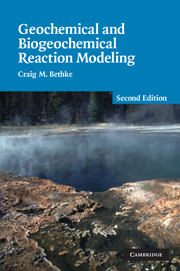Book contents
- Frontmatter
- Contents
- Preface
- Preface to first edition
- A note about software
- 1 Introduction
- 2 Modeling overview
- Part I Equilibrium in natural waters
- Part II Reaction processes
- Part III Applied reaction modeling
- Appendix 1 Sources of modeling software
- Appendix 2 Evaluating the HMW activity model
- Appendix 3 Minerals in the LLNL database
- Appendix 4 Nonlinear rate laws
- References
- Index
2 - Modeling overview
Published online by Cambridge University Press: 05 August 2012
- Frontmatter
- Contents
- Preface
- Preface to first edition
- A note about software
- 1 Introduction
- 2 Modeling overview
- Part I Equilibrium in natural waters
- Part II Reaction processes
- Part III Applied reaction modeling
- Appendix 1 Sources of modeling software
- Appendix 2 Evaluating the HMW activity model
- Appendix 3 Minerals in the LLNL database
- Appendix 4 Nonlinear rate laws
- References
- Index
Summary
A model is a simplified version of reality that is useful as a tool. A successful model strikes a balance between realism and practicality. Properly constructed, a model is neither so simplified that it is unrealistic nor so detailed that it cannot be readily evaluated and applied to the problem of interest.
Geologic maps constitute a familiar class of models. To map a sedimentary section, a geologist collects data at certain outcrops. He casts his observations in terms of the local stratigraphy, which is itself a model that simplifies reality by allowing groups of sediments to be lumped together into formations. He then interpolates among his data points (and projects beneath them) to infer positions for formation contacts, faults, and so on across his field area.
The final map is detailed enough to show the general arrangement of formations and major structures, but simplified enough, when drawn to scale, that small details do not obscure the overall picture. The map, despite its simplicity, is without argument a useful tool for understanding the area's geology. To be successful, a geochemical model should also portray the important features of the problem of interest without necessarily attempting to reproduce each chemical or mineralogical detail.
Conceptual models
The first and most critical step in developing a geochemical model is conceptualizing the system or process of interest in a useful manner. By system, we simply mean the portion of the universe that we decide is relevant. The composition of a closed system is fixed, but mass can enter and leave an open system.
- Type
- Chapter
- Information
- Geochemical and Biogeochemical Reaction Modeling , pp. 7 - 26Publisher: Cambridge University PressPrint publication year: 2007

